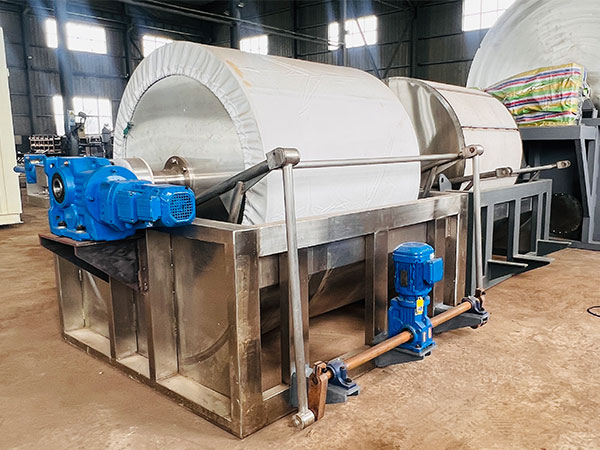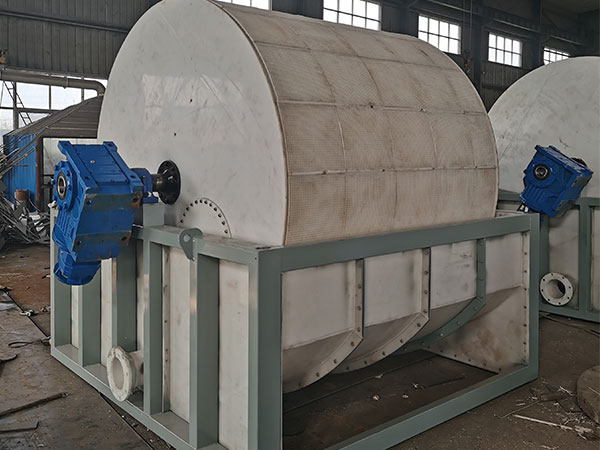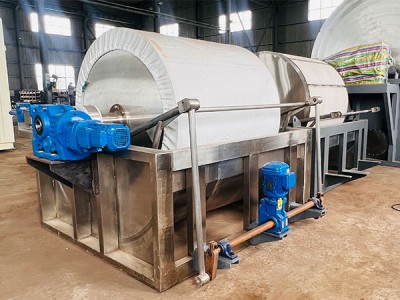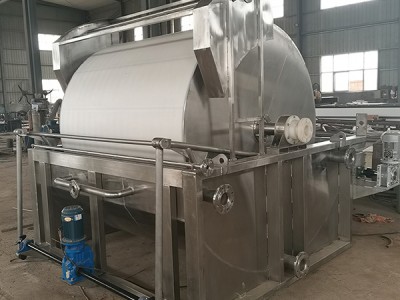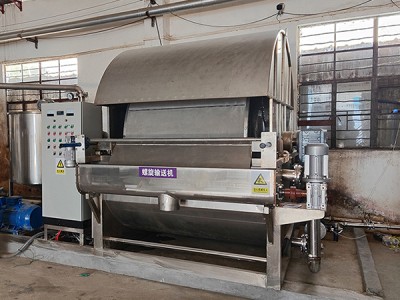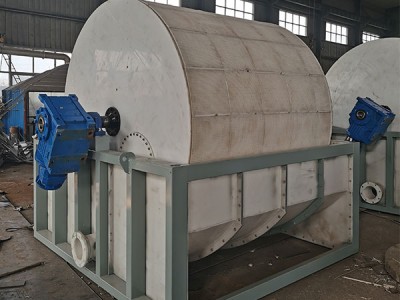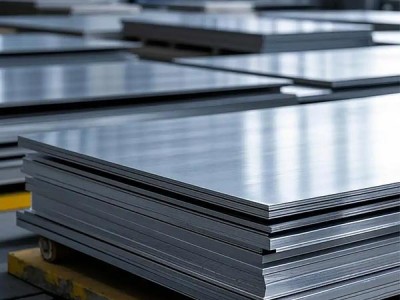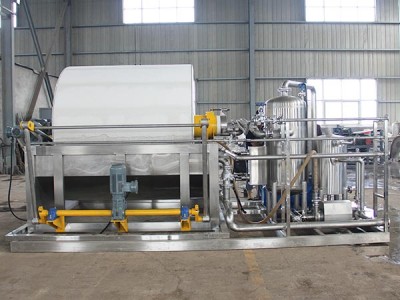Product Overview
The continuous rotary vacuum filter an indispensable solid-liquid separation device in modern industry, has gained widespread favor among enterprises due to its unique operating principle and high-efficiency performance. This equipment ingeniously utilizes vacuum negative pressure as its power source, driving specially designed filter cloths to come into full contact with the slurry through the uniform rotation of the filter drum. It seamlessly completes the four critical processes of filtration, washing, drying, and unloading in a continuous operation.
Compared to traditional filtration equipment, the continuous rotary drum filter performs exceptionally well in terms of energy conservation and reduced consumption, effectively achieving a perfect combination of high efficiency and energy savings.
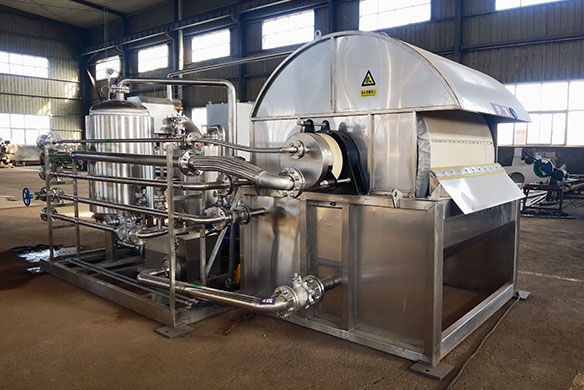
Core Advantages
Continuous Operation
The rotating drum remains in continuous rotation, enabling the entire filtration process to proceed without interruption, thereby meeting the demands of large-scale production.
High Degree of Automation
The system can automatically perform a series of operations including feeding, filtration, washing, and sludge discharge, significantly reducing the need for manual intervention.
High Adaptability
By flexibly adjusting the rotation speed of the rotating drum, vacuum pressure, and washing method, the system can easily handle slurries of varying viscosities and particle sizes.
Working Principle:
The working process of the continuous rotary vacuum filter primarily relies on the rotational movement of the drum and precise vacuum zone control. Its core principle involves utilizing the pressure difference between the interior and exterior of the drum to complete the filtration process.
Solid-liquid separation stage: The drum rotates at a lower speed, partially submerged in the tank containing the slurry. The area in contact with the liquid surface is defined as the “filtration zone,” and the vacuum system simultaneously activates its suction function, creating a negative pressure environment inside the drum. Driven by the pressure difference, the liquid phase in the slurry passes through the filter cloth and pores covering the drum surface, and is sucked into the drum cavity via internal pipes; while the solid particles are retained by the filter cloth, gradually accumulating on the outer surface of the filter cloth to form a porous “filter cake layer.”
Impurity Cleaning Stage: As the drum continues to rotate, the filter cloth area with the filter cake enters the “washing zone.” The spray nozzles pre-set in this zone activate, uniformly spraying the washing solution onto the surface of the filter cake. Under vacuum suction, the washing solution penetrates the filter cake layer, dissolving and removing soluble impurities. Depending on process requirements, the washing solution can be collected via independent pipelines for separate treatment or mixed with the filtrate and discharged together.
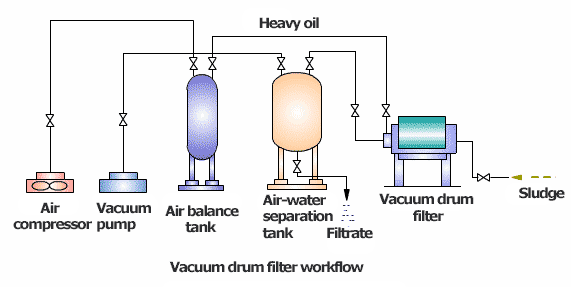
Moisture removal stage: The washed filter cake enters the “drying zone” as the drum rotates. In this zone, the spray system is shut off, and only the vacuum suction function remains active.
Filter cake separation stage: When the drum rotates to the “discharge zone,” the vacuum system is shut off, and the drum interior returns to atmospheric pressure. Simultaneously, the scraper device closely adheres to the surface of the filter cloth, completely peeling off the dried filter cake from the filter cloth. The filter cloth after peeling enters the cleaning station, where residual filter cake debris and impurities are removed through high-pressure rinsing. After surface cleaning, it re-enters the filtration zone to initiate a new operational cycle.
Throughout the entire process, the drum maintains continuous rotation. Its core control component, the “distribution head,” dynamically switches between vacuum and atmospheric pressure states to precisely divide the functional zones, ensuring that the filtration, washing, drying, and unloading stages are executed efficiently in the set sequence, thereby achieving continuous production operations.

Application Areas
Rotary continuous filter, with their high efficiency and continuous operation capabilities, have found widespread application in industrial sectors with clear solid-liquid separation requirements.
Chemical Industry: They can be used for the filtration and processing of crystallization liquids from chemicals, inorganic salts, and dye intermediates, achieving efficient solid-liquid separation.
Mining and Metallurgy Industry: They can filter concentrate from mineral flotation and perform solid-liquid separation of metal salt solutions, enhancing resource utilization.
Food Industry: They play a crucial role in starch dehydration, sugar crystallization filtration, and solid-liquid separation in soy product production, ensuring the quality and efficiency of food production.
Environmental Protection Industry: They are suitable for sludge dehydration in wastewater treatment processes, such as activated sludge and chemical sludge, and can also achieve effective recovery of industrial wastewater residues, contributing to environmental protection efforts.
Pharmaceutical Industry: They can be used for filtering antibiotic fermentation liquids and performing solid-liquid separation of important extraction liquids.
Continuous rotary filter Main Components:
The continuous rotary vacuum filter achieves efficient and stable operation through the coordinated interaction of its core components. Its main components can be divided into three categories: core filtration components, power and negative pressure components, and auxiliary functional components.
1. Core Filtration Components
Drum: The core operational component of the equipment, typically cylindrical in shape. The material is selected based on the characteristics of the slurry, typically stainless steel 304/316L, fiberglass, or rubber-lined, with corrosion resistance. The surface is uniformly distributed with 0.5-2mm filter pores, covered with filter cloth. During operation, it is partially submerged in the slurry tank, rotating to sequentially complete filtration, washing, drying, and dewatering. The internal space is divided into filtration, washing, drying, and dewatering zones by a distribution head, ensuring seamless continuity between each stage.
Filter cloth: The surface filtration medium of the drum, made of polyester, nylon, polypropylene, or stainless steel mesh, depending on the characteristics of the slurry. It must be resistant to acid and alkali, wear-resistant, and have pore sizes suitable for retaining particles. Its function is to intercept solid particles to form a filter cake, allowing the liquid to flow through the drum, thereby determining filtration efficiency and filter cake purity.
Slurry tank: Holds the slurry to be filtered, typically rectangular in shape, with the same corrosion-resistant material as the drum. Some models include a stirring device to prevent solid settling and maintain uniform concentration. The lower portion of the drum is submerged, with adjustable immersion depth affecting the formation of a 3–20 mm thick filter cake.
Distribution Head (Vacuum Distribution Valve): The “connection hub” between the drum, vacuum system, and atmospheric pressure piping, fixed at one end of the drum's axis. It has a ring-shaped channel corresponding to the drum's functional zones. When the drum rotates, it automatically connects the filtration zones to the vacuum system to create a vacuum, and connects the discharge zone to atmospheric pressure or compressed air, enabling pressure switching to ensure continuous operation.
2. Power and Negative Pressure Components
Transmission System: Consisting of a motor, reducer, and transmission gears, it drives the rotor to rotate at a constant speed. The speed can be adjusted using a variable frequency motor to accommodate different slurry filtration speeds, such as reducing speed for high-viscosity slurry to ensure filter cake thickness.
Vacuum System: The core power source for filtration, comprising a water ring/Rotor vacuum pump, gas-liquid separator, and vacuum piping. It creates a vacuum inside the rotating drum, promoting liquid flow through the filter cloth to achieve filter cake washing and drying.
3. Auxiliary functional components
Discharge device: Consisting of stainless steel or tungsten carbide scrapers and scraper adjustment brackets, installed on the outer side of the rotating drum in the discharge zone. During operation, the scrapers closely follow the filter cloth to remove the dried filter cake, with directly adjustable angle spacing to ensure thorough discharge without damaging the filter cloth. Some models are equipped with a belt conveyor for automatic transfer of the filter cake.
Washing System: Consists of a washing liquid storage tank, spray pipes in washing zones 1–3, and flow control valves. Washing liquid is sprayed onto the filter cake to remove soluble impurities and improve cake purity. The washing liquid is either vacuumed into the drum for separate collection or mixed with the filtrate.
Filter cloth maintenance device: Includes filter cloth tensioning rollers on both sides of the drum and high-pressure washing spray pipes behind the discharge zone.
Control system: Typically uses a PLC with a touchscreen to monitor parameters such as vacuum pressure, speed, liquid level, and flow in real time, supporting automatic adjustment. High-end models can be integrated into the factory DCS system for centralized control.
Customized Continuous Rotary drum Filter
In industries such as chemicals and mining, where high-intensity continuous operations are required, or in food and pharmaceutical sectors where strict purity and compliance standards must be met, the vacuum drum filter consistently maintains high efficiency and stability. It not only operates continuously and automatically but also features precise vacuum control and multi-stage washing functions, ensuring stable moisture content in the filter cake and improved filtrate recovery rates, directly reducing raw material waste and post-processing costs.
We all know that reliable equipment is the true key to peace of mind. Therefore, in addition to customizing the machine type according to your needs, we will also guide you on how to use it, and you can contact us anytime for any issues. Choosing this vacuum drum filter machine is not just about purchasing a machine; it’s about finding a reliable partner to help you produce and generate profits.
Hot Tags:


